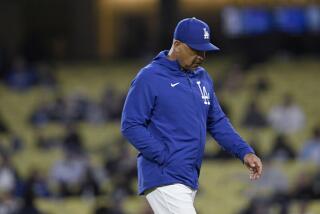You Can’t Get Him Out, He Never Gives In
- Share via
When Lenny Dykstra picked a fight with Rick Dempsey recently, no one in baseball was surprised. If he’d been there at the time, Lenny Dykstra would have picked a fight with Jack Dempsey. And expected to win.
Lenny Dykstra doesn’t belong in this point in time anyway. Lenny Dykstra is right out of a Norman Rockwell Saturday Evening Post cover of a ballplayer, and his style of play is right out of 1910. He should be matching spikes with Ty Cobb, trading insults with John McGraw, playing on a team called the Gas House Gang. Lenny is like a lot of us, in the wrong century. McGraw would have loved him. He would have been Casey Stengel’s pet.
Lenny doesn’t play that la-dee-dah stand-around game so favored nowadays where you get on base and wait for the three-run homer. Lenny plays it as if it were a guerrilla attack on a munitions train. Lenny doesn’t take prisoners either. Lenny doesn’t make friends. He comes to beat you. How doesn’t particularly matter. In the old neighborhoods, his nickname would be Stinky. As it is, it’s “Nails,” which should give you an idea. Lenny doesn’t have much give to him.
Lenny doesn’t show up at the ballpark in a three-piece suit with a briefcase and a beeper phone. Lenny shows up in cowboy boots and a T-shirt that might have a picture of a pizza on it. Lenny always looks as if he just climbed down from the cab of a hot truck. No one knows if he even owns a tie.
He always has this big chaw of tobacco stuck in his right cheek with juice dribbling down his chin. If he’s not chewing tobacco, he’s smoking it. He retreats to the training room before games to have a cigarette or two. It’s not to calm his nerves. Lenny doesn’t have any. It’s probably because somebody told Lenny tobacco was bad for him. Lenny hates to be told what to do.
You know, you think of a kid brought up in Southern California within earshot of the beach and right away you get this picture of a blond hunk with a surfboard under his arm and a bottle of Perrier, saying, “Outta sight!” all the time.
Even though he was born and raised there--Garden Grove, not far from the waves of Newport Beach--Lenny Dykstra is about as far from that stereotype as you can get. He looks as if he should be a hockey player. He would have been as at home in the teeming tenements of New York or the toughest range in Texas. Lenny revels in combat.
Andy Van Slyke, no less, considers him a health hazard. Lenny has turned center field into the world’s biggest spittoon, Van Slyke complains. He should have a Surgeon General’s warning on him. If you’re looking for Lenny, follow the trail of tobacco juice. It’s like finding the source of the Nile. Bring boots.
Lenny has always specialized in doing what he wants, not what he’s told. They put a warning track in big league outfields for guys like Lenny. He has hit more walls than A.J. Foyt.
They told Lenny he was too small, too light. They told him to cut down on his swing. There were a few times when they were glad he didn’t. When they talk of the New Mets’ 1986 season, the conversation usually gets around to the great 16-inning Game 6 of the playoffs against Houston. It was actually Dykstra’s ninth-ining triple that ignited the rally to allow the Mets to get back in that game. They were trailing, 3-0, going into the ninth when Dykstra got them off the floor.
It was Dykstra’s 16th-inning single that eventually provided the winning run, but it was Dykstra swinging for the home run he wasn’t supposed to hit that won Game 3 for the Mets, 5-4, after they went into the ninth trailing, 4-3.
The word most often applied to Lenny Dykstra was pesky . For Houston that year, it was a little like calling Babe Ruth pesky .
Lenny, traded to the Phillies, lifted weights over the winter to bulk up from 155 to 190. Oddly enough, instead of encouraging Lenny to swing for the fences, it had the opposite effect. He now felt he had enough power without the full 360-degree swipe and he began to slash hits to all fields. At the close of business Wednesday, his average was the highest in the big leagues.
Interviewing Lenny Dykstra is like chasing a bus. Lenny is always in motion. In New York one day, he suddenly dashed into the clubhouse from the training room late. “Can we do this after the game?” he asked the reporter waiting there. “I gotta get out there.”
After the game, the clubhouse was locked. The Phillies had blown a big ninth-inning lead and were in no mood to talk.
At Dodger Stadium last week, Lenny sat in the trainer’s room having his last-minute smoke. “Can we do this tomorrow?” he pleaded.
Lenny is not uncooperative, just always in a hurry. He always looks as if he were 10 minutes late. On the subject of anyone’s ever hitting .400 again--which Lenny flirted with this season--Lenny shakes his head. “No, not with split-fingered fastballs, relief pitchers and franchises 3,000 miles apart on the schedule; .350 is a great average today.”
What’s he doing differently? “Playing every day,” Lenny retorts. Is he more selective at the plate? “I’m tied for the lead in bases-on-balls--and ahead in hitting,” he points out. “I’m selective. But not too .”
He’s not a pest anymore. He’s a full-fledged menace--like a tarantula photographed through a magnifying glass, the word for Lenny is now scary .
More to Read
Go beyond the scoreboard
Get the latest on L.A.'s teams in the daily Sports Report newsletter.
You may occasionally receive promotional content from the Los Angeles Times.










